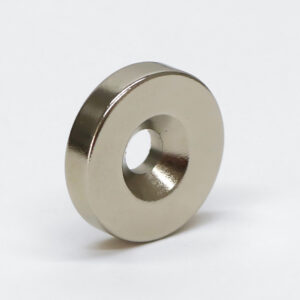There are at least 3 typical benefits that the countersunk holes can offer.
First, they eliminate the gap between the 2 surfaces that should join by using magnetism and maximize the bonding effects.
Second, countersunk holes can distribute the load of the screws more evenly across the surface of the neodymium magnets – which are fragile – and prevent cracks and breaks due to excessive pressure on specific spots.
Third, this can give a more beautiful appearance, especially if the magnets are visible.
2. Dimensional identifications
The dimensional identifications – for neodymium magnets with countersunk holes – are the same as for other shapes.
The major difference is you will need to specify the diameters, angles, and positions of the countersunk holes.
Countersunk holes (also called screw holes) include a primary hole and a major hole.
d for the inner diameter
M for the diameter of the major hole
Better to include the countersunk angles
Better to indicate the diameters with exact numbers, rather than general model numbers like M4.
There are the metric units and the imperial units; sometimes the difference can make the screws and holes won’t match.
3. Available dimensions
The available overall dimensions are the same as for other shapes.
Neither the width nor the length of the magnet can be smaller than the major hole diameter, and better to leave a distance of at least 1 mm.
We will need to make chamfers on their edges as well.
4. Grades
Neodymium magnets have different grades, ranging from N35 to N55, and they also have high-temperature designs for special applications.
You can refer to our introduction to neodymium magnet grades. It will be helpful for you to determine which grade is the most appropriate for you.
5. Magnetization directions
The magnetization directions for neodymium magnets with countersunk holes will remain the same as their bodies without the countersunk holes.
No special consideration for the designs with holes.
Suppose you need a disc neodymium magnet with a hole in the center, the magnetization directions will be the same as the disc without this hole.
7. Optional designs
Countersunk holes should have correct diameters and angles to fit the screws that will be used.
In this way, you will be able to insert the screws straight into the magnetic assemblies. If the holes are not aligned properly, this can cause the screws to bind or be difficult to assemble.
The smoothness: The edges should be smooth and have no burrs or rough spots. These minor defects can cause screws to bind or reach the correct positions.
The depth: The depth of the holes must be correct for the length of the screws. The holes should be deep enough for you to fully insert the screws, so they may not cause gaps between the magnet surfaces and magnetic assemblies.
Disadvantages of magnets with countersunk holes
- The major advantage of making countersink holes in neodymium magnets is to replace the double-sided tapes for fixing and positioning the magnets.
- However, this also has a disadvantage as well – countersinking holes would weaken the magnets’ magnetism and mechanical strength.
- Making countersunk holes in neodymium magnets reduces the material of the magnet.
- That will decrease its magnetic strength.
- Instead of countersinking holes in neodymium magnets, people typically use other methods to attach them to a surface, such as adhesive or other mechanical fasteners.






